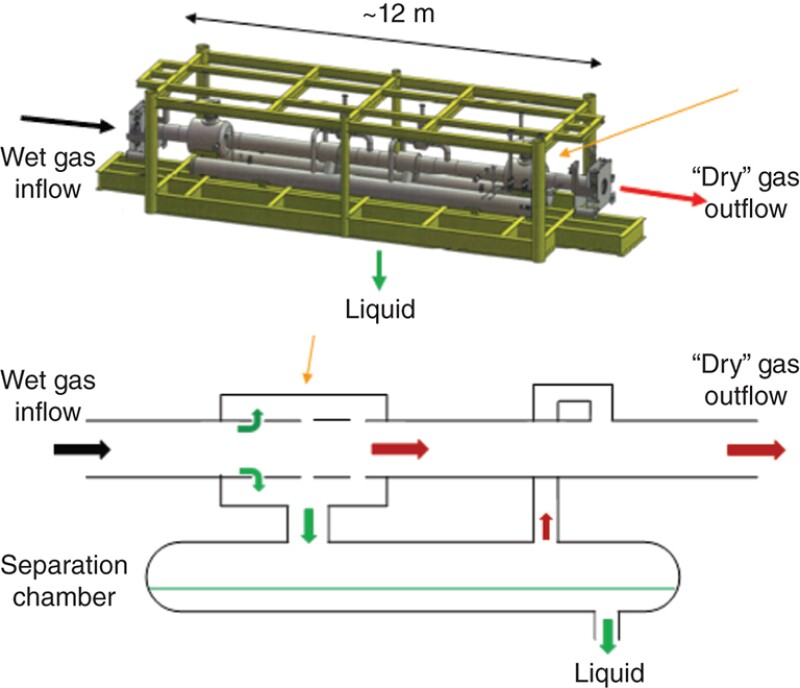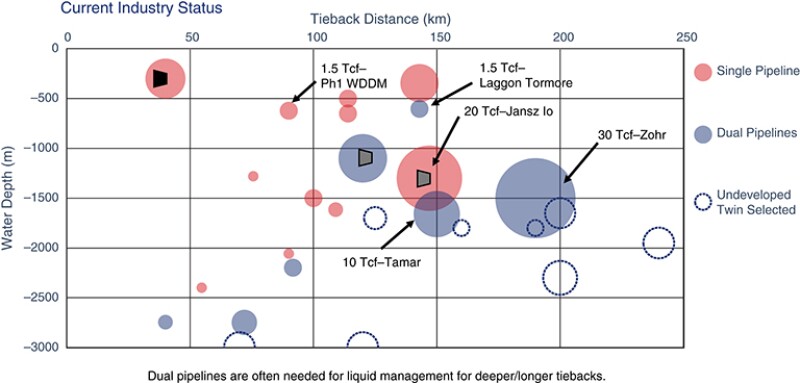A promising innovation with a ponderous name, pseudo dry gas (PDG), opens the possibility of developing stranded-gas fields in remote locations by making it possible to build far-longer tiebacks and ultimately produce more gas.
But it comes with a major challenge: convincing offshore producers that they can rely on a subsea system that separates natural gas from the condensate and water in the production stream.
The benefits are obvious. Being able to move gas and liquids separately is a lot more efficient and avoids problems associated with multiphase flow, particularly slug formation, which requires topsides equipped to catch the slugs. Separation also reduces backpressure, which is expected to increase the ultimate recovery from those fields.
In the 4 years since the idea debuted at the Offshore Technology Conference (OTC), a small team in Worley’s Aberdeen office has built and successfully tested a small-scale prototype of a flow loop with the support of an industry partnership including three unnamed energy companies.
Even with all of that, they needed to establish an added benefit to win a critical government grant to build and test a full-scale prototype for high-pressure testing. This energy-efficient alternative promises to significantly reduce carbon emissions compared with offshore compression and platforms.
“As the energy industry strives toward sustainability, it’s important to support solutions that enable decarbonization,” said Andy McDonald, head of Low Carbon Transition at Scottish Enterprise, which put up £765,000 ($1 million) to support testing, according to a release from Worley.
They are currently building a full-scale unit to be tested later this year at the National Engineering Laboratory in Glasgow, pushing the device closer to the technical readiness level that will allow an offshore field test.
This new approach is competing against two well-established alternatives—platform-based development and compression. Their counterargument is based on the energy efficiency of separation, which limits the compression required and the steel that goes into platforms.
When comparing the energy required, Thomas Lee, lead development engineer at Worley who co‑invented PDG, pointed out that the power required for separation is measured in thousands of watts, while compression requires millions of watts.
“It effectively decarbonizes upstream gas production. It gets rid of compression from the gas field. The amount of CO2 from this operation is really low,” Lee said.
The amount of carbon and cost also depends on the location of the compression equipment. Normally it has been on a platform, which provides power and easy access for maintenance but adds costs and carbon. Worley’s inline separator is built to fit into the space filled by a standard joint of pipe (Fig. 1). Onshore compression is also an option, and Equinor and Shell have shown that compression can be done subsea.

Compression has been used in projects around the world, the majority of which are in fields that hold reserves of 10 Tcf or more (Fig. 2).

“There are not many of those in world,” Lee noted, adding that globally there are a lot of gas fields that cannot be developed, including many in deep waters in the West Shetlands north of Scotland.
A Worley paper showed that while PDG is the lower-cost and lower-emissions option, selling this idea is going to require convincing offshore engineers that subsea separation is a reliable, cost‑effective, and long-term solution.
Subsea separation has long been a goal for oilfield technology leaders such as Equinor and Petrobras, with mixed results. Their subsea oil/water/gas separators have worked in tests but have rarely been used. The failure to move into widespread use was a topic of a paper session at last year’s OTC, where speakers had no ready solution to the problem.
A significant difference is that Worley appears to be taking on a less-challenging task than past efforts in oil fields.
Petrobras’ goal was to extend the life of its aging Marlim field by removing a large volume of water from the production stream, which was limiting its future oil production. That required multiple processing steps as well as reinjecting a large volume of the water removed into an underground formation (OTC 24533).
In comparison, gas is relatively easy to separate from condensate and water as it flows through a pipe, and the volume of fluid Worley is dealing with is considerably lower.
Worley’s separator is designed to handle up to 100 bbl of liquids per MMscf—about a 37% water cut on a BOE basis. The fields they are looking at serving are often well below that limit.
Gas Looks Easier
The Worley liquid removal unit is built using off-the-shelf hardware with no moving parts and includes openings wide enough for cleanout by a pipeline pig.
The steps involved in the inline separator are:
- The condensate and water flow separately through the pipe.
- The fluid is removed from the gas in the unit, which returns the gas to the pipe.
- Gas, liquids, and water flow down into a holding tank, allowing further separation before transport down a separate smaller line.
Worley has set a 15-minute holding time for the final separation, but the fluid will remain in the tank until the control system determines there is a sufficient volume to pump it efficiently.
The device’s design and control system were tested last year in a flow loop at Cranfield University to measure how effectively the initial prototype separator removed fluid under a variety of conditions. Different fluid and gas mixes were run based on actual field production ranging from uphill flow to sand mixed in the production (SPE 200917).
It passed all those tests, which in some cases led to changes such as a new sand-removal design. But the energy company experts kept asking a question for which there was no answer: Would the unit perform as well at real-world flow rates?
The device, sheathed in clear acrylic, provided a view of the flows through the separator, but its 7-bar pressure limit fell far short of the pressure required to simulate real-world flow rates of up to 150 bar. The testing of the full-scale prototype will help determine its operation under real flow-rate conditions.
Higher flow rates are known to reduce separator efficiency. When simulations were run during the testing, some performance reductions were seen, but Lee said the results were still above the limits they had set.
While there is no substitute for the full-scale test, Lee said it is “looking positive, with simulations based on the correct physics verified to the prototype tests. A huge amount of work has been done on this. Everything says this should work.”
If the system passes the full-scale prototype tests, the next step will be an offshore test to see how the separator, pump, and control system perform when integrated into an offshore pipeline.
Blue Hydrogen Gas Line
If all goes as planned, it will be years before an actual system can be installed. A paper from last year’s OTC goes into detail to compare the costs and rewards using PDG and three other methods connecting a string of stranded West Shetland fields to land (OTC 30941).
The fields are in waters 200 km north of Scotland, nearly the length of the longest connection ever using compressors. They are among many in the North Sea whose size and location preclude development.
The paper considered four options:
- A floating production, storage, and offloading vessel (FPSO) with a gas pipeline to shore using compression from day 1
- A dual, 18-in. flowline to shore, with onshore compression beginning 2 years after the start of production
- A dual, 18-in. flowline to shore with subsea compression added 2 years after production starts, followed later by onshore compression
- A line using PDG, with four separation units along the 30-in.-diameter gas pipeline, and a smaller liquids line
The paper offers a detailed description of the steps taken to quantify the power consumption of the equipment associated with each scenario and the emissions it would likely contribute. That analysis was reviewed by five operators working in the Net Zero Energy Centre, formerly known as the Oil & Gas Technology Centre.
The analysis showed the ultimate expected production over the life of the project was similar for three of the four options—an FPSO; the PDG design; and subsea compression.
Where they differed was in energy intensity. The PDG option was the second-lowest in energy consumed and the lowest in emissions per unit of gas produced.
The lowest-cost option used only onshore compression, which reduced energy use but also yielded the lowest ultimate production.
When it came to the bottom line, the PDG option ranked the highest with a total cost of $3.3 billion and expected revenue of $9.6 billion for a $6.6-billion net. In comparison, the net for the FPSO option was $4.3 billion, and the subsea compression option was $4.7 billion. In both cases, their expected revenue was nearly equal to PDG, but their margin was reduced by costs exceeding $4.5 billion.
Worley’s grant to develop its lower-carbon option reflected the concerns of Scottish officials who have prioritized the development of a blue hydrogen industry in the north of Scotland.
Doing that will require both an affordable and local source of gas to supply the shore facilities that will break down the gas into hydrogen and CO2.
Since they are competing with green hydrogen, where the energy source is renewable and the feedstock is water, they need to minimize the emissions associated with production and transport of the gas feedstock. The location in the north of Scotland also offers them ready access to neglected gas resources and proximity to the ample empty pore space in depleted old North Sea fields, where that CO2 can be pumped into permanent storage.
While that plan is providing critical money for Worley, if this technology delivers on its promise to allow tiebacks running twice as far as the longest-ever using compression, there’s a world of opportunities.
For Further Reading
SPE 200917 Experimental Separation Performance of In-Line Piggable Liquid Removal Unit—Pseudo Dry Gas Systems by L. Liebana, L. Thomas, and Terry Wood, Intecsea Ltd.; L. Lao, Cranfield University; G. Rogerson, Oil & Gas Technology Centre.
OTC 30941 Pathway to Decarbonisation and Maximum Value Recovery for Remote Offshore Gas Fields by L. Thomas, L. Liebana, T. Wood, and A. Mansour, Intecsea; A. Coaker and R. Hunt, Worley; and G. Rogerson, Oil and Gas Technology Centre.


